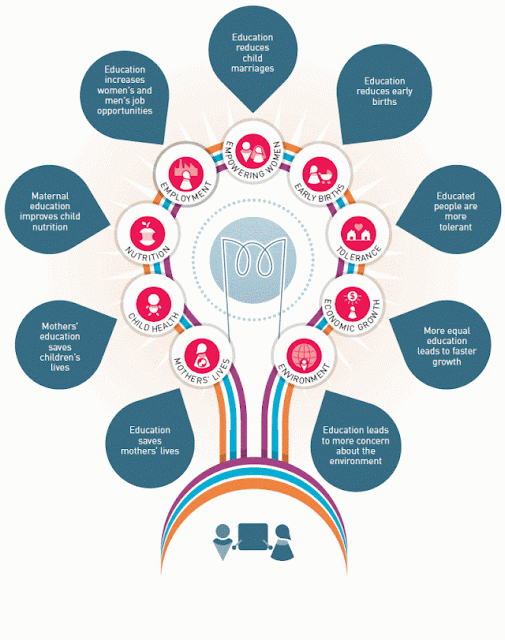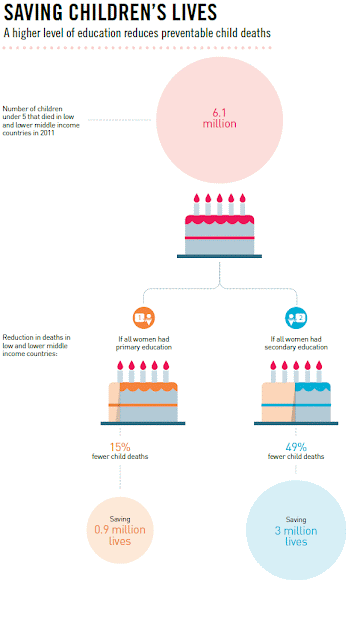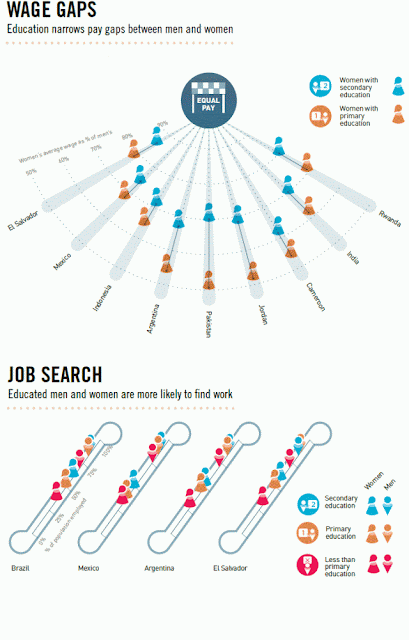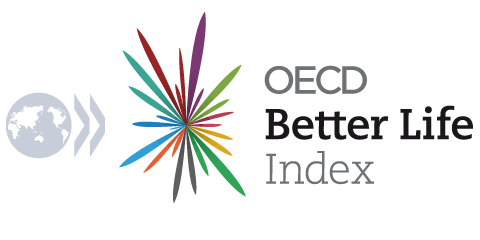Visualise How Education Transforms Lives
Education Transforms Lives
 |
Education lights every stage of the journey to a better life, especially for the poor and the most vulnerable. Education’s unique power to act as a catalyst for wider development goals can only be fully realized, however, if it is equitable. Education empowers girls and young women, in particular, by increasing their chances of getting jobs, staying healthy and participating fully in society – and it boosts their children’s chances of leading healthy lives. To unlock the wider benefits of education, all children need the chance to complete not only primary school but also lower secondary school.
|
Education Empowers Women to Overcome Discrimination
 |
One in eight girls is married by the age of 15 in sub-Saharan Africa and South and West Asia, and one in seven has given birth by the age of 17. Ensuring that girls stay in school is one of the most effective ways of averting child marriage and early birth. Education is also a key factor in hastening the demographic transition to lower birth and mortality rates.
In Ethiopia, 32% of girls with less than primary education were married before the age of 15, compared with less than 9% of those with secondary education.
If all countries expanded their school systems at the same rate as the Republic of Korea and Singapore, there would be almost 850 million fewer people in the world by 2050 than if enrolment rates remained at 2000 levels.
|
Education Can Save the Planet
 |
Education can encourage people to use energy and water more efficiently and recycle household waste. In poor countries affected by climate change, education helps people adapt to its effects.
Across 29 countries, 25% of people with less than secondary education expressed concern for the environment compared to 37% of people with secondary education and 46% of people with tertiary education. Investing between US$11 billion and US$14 billion per year in basic education for girls globally would help their households make better choices to counter the effects of expected weather-related disasters.
|
Equal Education Boosts Economic Growth
 |
Education not only helps individuals escape poverty by developing the skills they need to improve their livelihoods, but also generates productivity gains that boost economic growth substantially. For growth to reduce poverty, however, it needs to overcome inequality by improving the lives of the poorest and marginalized the most.
If education inequality in sub-Saharan Africa had been halved to the level of Latin America and the Caribbean, the annual per capita growth rate over 2005–2010 would have been 47% higher.
|
Educating Girls Can Save Millions of Lives
 |
There are few more dramatic illustrations of the power of education than the estimate that the lives of 2.1 million children under 5 were saved between 1990 and 2009 because of improvements in girls’ education.
Education is one of the most powerful ways of improving children’s health. Educated mothers are better informed about specific diseases, so they can take measures to prevent them. They can recognize signs of illness early, seek advice and act on it.
India and Nigeria account for more than a third of child deaths worldwide. If all women in both countries had completed secondary education, the under-5 mortality rate would have been 61% lower in India and 43% lower in Nigeria, saving 1.35 million children’s lives.
In Burkina Faso, if all women completed primary education, the under-5 mortality rate would fall by 46%; if they completed secondary education, it would fall by 76%. In sub-Saharan Africa, which accounts for 70% of the world’s HIV infections, 91% of literate women know that HIV is not transmitted by sharing food, compared with 72% of those who are not literate. |
|
 |
||
 |
In the Arab States, a one-year increase in maternal education is associated with a 23% decrease in the number of children under the age of five dying from pneumonia. In Cameroon, where the female secondary gross enrolment ratio was 47% in 2011, if all women had had secondary education, the incidence of malaria would have dropped from 28% to 19%. In low income countries, mothers who have completed primary school are 12% more likely than mothers with no education to seek appropriate health care when their child has symptoms of diarrhoea. |
A Mother's Education is Crucial for Her Own Health
 |
Every day, almost 800 women die from preventable causes related to pregnancy and childbirth, including pre-eclampsia, bleeding, infections and unsafe abortion. Educated women are more likely to avoid these dangers, by adopting simple and low cost practices to maintain hygiene, by reacting to symptoms, and by making sure a skilled attendant is present at birth. Education reforms increased education attainment among young women by 1.8 years in Kenya, accounting for a 34% decline in the maternal mortality ratio. In Nepal, 49% of literate mothers have a skilled attendant at birth, compared with 18% of mothers who are not literate. |
Education Keeps Hunger Away
 |
Malnutrition is the underlying cause of more than a third of global child deaths. Educated mothers are more likely to ensure that their children receive the best nutrients to help them prevent or fight off ill health, know more about appropriate health and hygiene practices, and have more power in the home to make sure children’s nutrition needs are met.
In South Asia, 22 million fewer children would be stunted if all mothers reached secondary education.
In Honduras, the chances of children being stunted – short for their age – is 54% if they are born to mothers with less than primary education, falling to 33% for those born to mothers with primary education, and to 10% if they are born to mothers with at least secondary education.
|
Education strengthens bonds between communities and societies
 |
Across 18 sub-Saharan African countries, those of voting age with primary education are 1.5 times more likely to express support for democracy than those with no education, and the level doubles among those who have completed secondary education.
In Turkey, citizens with secondary education are around twice as likely as those with only primary schooling to sign a petition and participate in a peaceful demonstration.
In Central and Eastern Europe, those with secondary education are 16% less likely than those who have not completed secondary education to express intolerance towards immigrants.
In Tunisia, while only 22% of those with less than primary education agree that democracy, despite its drawbacks, is the best system of governance, 38% of those with secondary education do so.
|
Education Enhances Job Opportunities
 |
If all students in low income countries left school with basic reading skills, 171 million people could be lifted out of poverty, which would be equivalent to a 12% cut in world poverty.
In El Salvador, only 5% of working adults with less than primary education have an employment contract, compared with 47% of working adults with secondary education.
In Jordan, 25% of women with only primary education who live in rural areas work for no pay, compared with 7% of those with secondary education.
In Pakistan, working women with good literacy skills earn 95% more than women with weak literacy skills.
In rural Indonesia, an additional year of schooling reduced the chances of falling back into poverty by 25%.
|
The information above comes from www.education-transforms.org.
- Melinda George

Kommentare